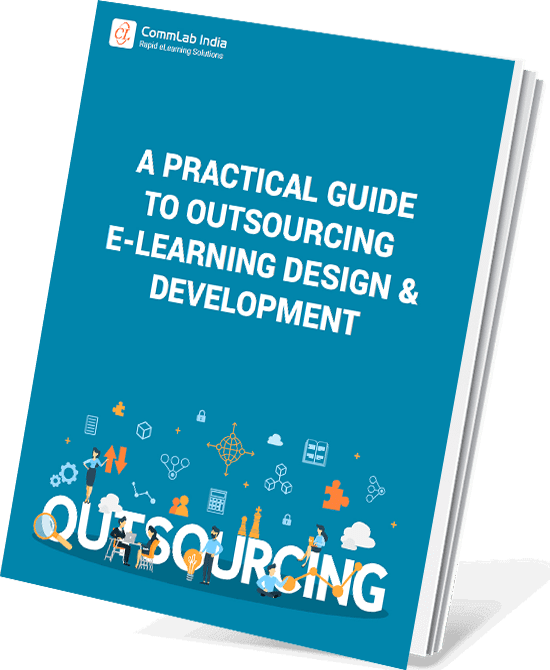8 Crucial Points To Consider When Outsourcing E-Learning Projects To India

Are you outsourcing your e-learning project to India? You have made the right choice. India, with its large number of English speaking professionals and ability to offer a better turnaround time has emerged the preferred destination for outsourcing e-learning projects.
Remember e-learning development is work that involves a high level of skills and needs an understanding of e-learning tools, learning objectives, training needs, and business goals of the organization and, learning preferences of the learners. Your e-learning vendor has to understand these aspects while providing you access to experienced talent, quick turnaround, and cost savings. Indian vendors can provide this expertise. In fact, a report by Bersin Deloitte suggests e-learning development costs 20 to 40% less in India.
These factors make India the preferred choice for outsourcing e-learning projects. But there are certain issues peculiar to the country which you must evaluate carefully before you decide on an Indian vendor.
Though these issues can be deterrents in making a decision, you can always find ways to work around them and take advantage of the expertise and cost efficiency Indian vendors bring to the table on e-learning projects.
Some of the typical issues a company may face with an Indian outsourcing partner are communication issues, language barriers and cultural differences, and data security issues.
→ Download eBook: Selecting the Right Vendor for eLearning Development Outsourcing
Communication
Good communication is crucial for any outsourcing arrangement to succeed. Issues are an integral part of an outsourcing agreement, so communication is crucial to resolve them. Sharing of information in a proper and effective manner ensures there is clarity of objectives and interests on both sides.
In e-learning development, the ability to maintain a constant flow of communication with the vendor is required to maintain long-term relations. Continuous communication is necessary so that the vendor is able to deliver according to the client’s requirements. Ways to do this are:
- Setting clear communication channels
- Fixing pre-determined times for regular interactions
- Engaging in proactive communication
But the difference in time zones creates a problem, especially if it takes more than 24 hours to get a query answered. This becomes crucial with faster delivery times and agile development cycles.
The ability of the vendor to promptly respond to queries should be assessed before making a decision. So it is important to know about the different communication tools such as telephone, emails, Skype, Project Management Tools, and other platforms the outsourcing partner will use to keep the communication going.
Communication will be easy with the vendor in English, considering the fact that a large percentage of Indian professionals are familiar with the language. This ensures good communication but when it comes to other languages, Indian vendors will have to communicate through a person familiar with the language. He will act as a conduit and keep the communication flow going. This will avoid delays and misunderstanding of project requirements.
Cultural differences
The difference in working styles between companies in India compared to companies in the West and elsewhere can lead to reduced efficiency. The differences in corporate and regional cultures can lead to differences in approach to the project.
The variations in decision making and organizational structure can also jeopardize the project. This can be avoided if both the parties make efforts to understand each other’s culture, norms, and customs. Indian vendors are often willing to share with their clients their initiatives to train employees on cultural awareness.
Their attitude towards work must also be assessed. Employees working on the project need to understand the big picture to be motivated and work on the project. Check out how much time and effort the vendor invests in communicating this to them. It is important to know how they handle challenges and how issues will be resolved during the course of the project. You can get an insight into these issues by talking to clients who partnered with the company earlier. This will help you gauge their level of customer service.
Time Zones
Time zone differences are yet another challenge when outsourcing to India. For instance, the time difference between India and the United States (the primary country for business) is about 12 hours, which means there is no reasonable time to communicate with the team in India. E-learning development requires continuous communication so that the vendor is able to deliver according to the client’s requirements. This difference in time zones can lead to a lack of communication at crucial junctures of the project and mismatched project milestones and deliveries.
This issue can be resolved by sending some employees from the vendor’s firm to the client site to resolve problems at their side. Deciding on certain fixed times for regular interactions can also solve the problem to some extent. Finding about the collaboration levels among distributed teams will give you an idea of the vendor’s measures to handle different time zones.
Data Security
The outsourcing partner has to protect sensitive information and adhere to data protection standards. The Non-Disclosure Agreement should have clear terms so that such information can be shared without apprehensions. There should be enough confidence to trust the vendor with sensitive information. Obtain information on the vendor’s Information Security policies and their practices to limit access to information during the development process.
Experience
To gain advantage of the Indian expertise in e-learning, look for companies with 10 to 15 years of experience in the field. The management should have global exposure and a mindset with the right perspective on culture and language differences to handle projects efficiently.
The team should have good experience in learning design, instructional design, and learning development. They should have qualified in-house instructional designers and visual designers. Companies with experience mean faster turnaround and minimum productivity loss overheads.
The vendor should ideally have 50% or more of their revenue from custom e-learning projects. This means they have the required expertise and will provide the required support. They will invest more on enhancing skills and continuous improvement.
Look for expertise relevant to you. The vendor’s record of adhering to SLAs in earlier projects will indicate how well they will be able to meet your requirements.

A Practical Guide to Outsourcing E-Learning Design & Development
Tips and Best Practices for an Effective Outsourcing Journey
- eLearning Elements that can be Outsourced
- Tasks Before Outsourcing
- Tips for Selecting the Right eLearning Vendor
- Ways to Support your Vendor
Efficient project management
Initially, you will be interacting with the account management and project management teams; find out about the team that will be aligned with your project. It should have adequate experience in elearning development. Check if they can scale up at short notice, if required. Find out the number of concurrent projects a team handles and their turnaround time.
Find out about the development process, supporting assets, and the flexibility of their workflow that can support your project. It is important to know how they handle challenges and how issues are resolved during the course of the project. Assess their risk management and mitigation measures and steps to ensure timely delivery.
From your side, ensure your targets and objectives are clearly specified. Detailed documentation and explanation of each task, and the techniques to deal with complicated tasks is required to establish clarity of your requirements. This will help the vendor precisely understand your needs.
Check out demos and samples developed by the vendor, to assess their competency and ability to fulfill requirements. You can check on their quality assurance processes and systems that will help you judge their adherence to quality.
You should also factor in the costs, especially the total cost of outsourcing (TCO) before taking a decision.
Clientele and references
Good client reviews and references establish the credibility of the vendor. They will provide insights into the projects the vendor has handled earlier. Check out the reliability of the vendor by asking references about details of projects handled earlier, technology or software used to develop the project, and adherence to deadlines.
Processes and standardization
Processes in place will ensure e-learning development can be done efficiently and is of high quality. The project will require periodic reviews, status updates, and demos. The vendor must have processes in place to provide these. From your side, it is imperative that you visit your outsourcing partner’s workplace to find out about their processes, methodologies and team, factors that will determine the success of the outsourcing arrangement.
The need to handle huge volumes of work, tight deadlines, cultural and language barriers, and reduce costs can make outsourcing a tedious process. But if these issues are recognized in advance, they can be resolved with right planning and risks and concerns can be effectively managed. This will ensure the outsourcing partnership works well.
Now that you are aware of the basic issues and glitches you will encounter when outsourcing your e-learning projects to India, ensure you consider all of them before selecting a vendor. However, you cannot downplay the advantage Indian vendors offer in terms of cost, quality and customer service.
I hope this checklist will help you evaluate and choose the right Indian partner for your e-learning projects. The evaluation process and its outcome need to address at least some of the reasons which originally made you decide on the outsourcing route.
If you have any more points to share, do write to us.




![How to Choose An eLearning Vendor that’s Just Right for You! [Video]](https://blog.commlabindia.com/hubfs/Imported_Blog_Media/elearning-vendor-selection-guide-video-v2.jpg)
